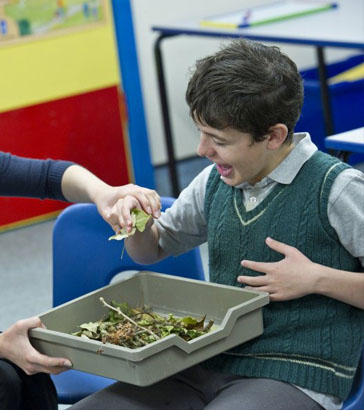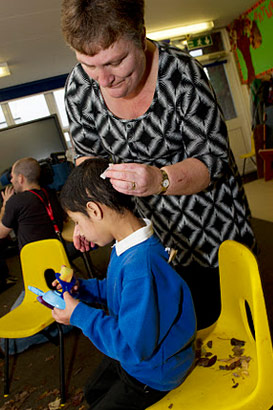
There's no doubt that our advances in understanding of the potential effects
of sensory impairments have moved on considerably since the 1990s, with
the publication of accounts from
people with autism.
It's well established that brain patterns and functioning, the information
the brain receives and the interpretation of sensory messages to the brain
can be vastly different for those on the autistic spectrum and equally different
from one individual to another (Smith Myles, Tapscott Cook, Miller, Rinner
and Robbins, 2000; Bogdashina, 2003; Grandin, 2006).
Our understanding of the effects of sensory confusion are naturally nowhere
near as certain for those with PMLD,
simply because they cannot tell us directly about their experiences, but
it seems reasonable to assume that sensory understanding may be equally
awry at least for some, and that we must be extremely cautious about making
assumptions that those with PMLD
perceive the world in the same way that
neuro-typically (NT) developing people generally do.
However, it's probably safe to assume there's a greater incidence of sensory
impairment among people with profound learning disabilities (Bunning, 1998)
and the degree of sensory impairment is also likely to be more severe in
type as the learning disability increases (Kiernan and Kiernan, 1994).

As a general rule, it's probably always best to consider your knowledge of a child's personal learning style.
Ask yourself the following questions:
- What do you already know about the children in your class and the way they engage best?
- Have you assessed their sensory functioning?
- Are you engaging in teaching practices that are designed to promote sensory and perceptual development?
- Are you using teaching methodologies that take pupil preference into account?
- Are these methodologies supported by specifically selected resources designed to maximise the specific learning
you
want to tackle?
Rather than subject a pupil to a battery of sensory stimulants in the
hope of striking lucky, a better starting point would be to begin with
the pupil's personal learning style and provide a safe, secure and predictable
learning environment into which sensory stimuli may be introduced gradually,
their impact upon the pupil's personal learning style noted, and elements
of good practice disseminated across the timetable into (other curricula)
subjects.
Richard Aird, 2001

Aird, R., (2001), The Education and Care of Children with Profound and
Multiple Learning Difficulties, London: David Fulton.
Bogdashina, O. (2003), Sensory Perceptual Issues in Autism and Asperger
Syndrome, London: Jessica Kingsley.
Bunning, K. (1998), To engage or not to engage? Affecting the interactions
of learning disabled adults, International Language and Communication Disorders.
Vol 33; pp 386-391.
Grandin, T. (2006), Thinking in Pictures, New York: Vintage Press.
Kiernan, C. and Kiernan, D. (1994), Challenging Behaviour in Schools for
Pupils with Severe Learning Difficulties, Mental Handicap Research.

Mednick, M. (2002), Supporting Children with Multiple Disabilities,
Birmingham: Questions Publishing.
Pagliano, P. (2001), Using a Multisensory Environment.
A Practical Guide for Teachers, London: David Fulton.
Smith Myles, B., Tapscott Cook, K., Miller N, Rinner, L., and Robbins, L.
(2000), Asperger Syndrome and Sensory Issues: Practical Solutions for
Making Sense of the World, Kansas: Autism Asperger Publishing Company.